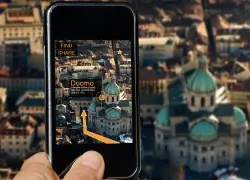
Augmented Reality that was good for mostly gaming a decade ago, has found promising applications in various segments such as commerce, art, architecture and education. With the added computing power and smart features, the mobiles and tablets are becoming the emperors of digital world of today resulting in a new platform to be opened for AR in the day-to-day life of common people. For rapid development of AR software, software development kits are available from Metaio, Vuforia, Bippar, Layar and CloudRidAR. A special data standard called Augmented Reality Markup Language (ARML) has been developed to achieve interoperability.
Thus Mobile Augmented Reality (MobAR) is becoming a mainstream topic from being the science fiction a decade ago. The various types of advanced displays, powerful multiple cameras, miniscule useful sensors and high processing power are ushering in a new age of mobile augmented reality. Going beyond just fun and gaming, MobAR is finding value in anatomy study (Anatomy 4D by DAQRI), road safety (iOnRoad Augmented Driving), tourism (wikitude), hobbies (Theodolite, Sky Map). While there is MobAR app (Black eyed peas) that places the user ‘inside’ her favorite band’s video, some players are seein g potential in marketing as an interactive layer to print advertisements. With ever- increasing population of mobile devices and their capabilities, mobile augmented reality is clearly seen as a new window opened into a vast untapped market.
Let’s see the potential opportunities in mobile augmented reality. In online retail, MobAR can bridge a major gap of lack of physical perception and please the shopper. If one is looking for a flower vase, she can choose a vase from the online site and actually ‘see’ it in the designated room corner before deciding to purchase it. Or one can ‘match’ the shoes with a new dress in closet to find a best fit. All the MobAR app needs to do is, get the image of the vase or shoe from the shopping site and overlay it onto the pointed object – the room corner or the dress. Do-it-yourself furniture is a booming business that can employ MobAR to enhance the assembly process beyond the present print manual. The assembly instructions can be delivered through MobAR with actual audio visual demo. Even work in progress furniture can be compared with pre-loaded images to point out mistake if any.
In e-learning, MobAR can reduce the learning cycle drastically with applications such as linguistic translations or visual guidance for onsite maintenance. Moreover, MobAR with wearable devices can improve the e-learning by situational simulation. In healthcare, often a doctor ends up explaining the condition of internal organs verbally to a patient. This can be bettered by ‘showing’ the affected organs superimposed with design images visually using MobAR. MobAR will be of tremendous help in case of remote checkup and telemedicine. Tourism industry is already taking lead in using MobAR and it can exploit it to large extent given the urge for fantasy and uncommon experiences by the modern young travelers. There seems to be infinite possibilities of employing MobAR commercially beyond gaming and entertainment.
However, looking at MobAR just as another gimmick to develop some killer apps is not correct, as commented by several expert panelists in a recent Mobile World Congress which discussed ‘MobAR – what is it for?’ They would like the developer community to see MobAR as a new user interface technology and not merely as something for which a killer app to be developed. They asked smart developers to imagine the phone camera as their own eye and think of what kind of information is of value, what augmentation of reality would give the mobile user better experience. This would bring a creative curiosity in the field of MobAR development and that will continue to enrich the user experience beyond expectations. Of course, there will be challenges – not only of limitations of existing hardware and software, but also of human lifestyle, cognition processes and medico-legal issues because you are tampering with the real reality of the user. But with due respect to the nature’s laws binding the human beings in their normal life, mobile augmented reality will have a significant positive impact on the modern life and society.
A paradigm shift has happened in the field of mobile by introduction of wearable gadgets such as googles, watches, gloves, earplugs, headgears etc. This will only expedite the application of mobile augmented reality into usual life of common people. With mainstream adoption of wearable gadgets, the MobAR will shift towards a different experience that will go beyond the edges of a small rectangular device occupying surrounding space. Let’s see how this technique unfolds in near future.






